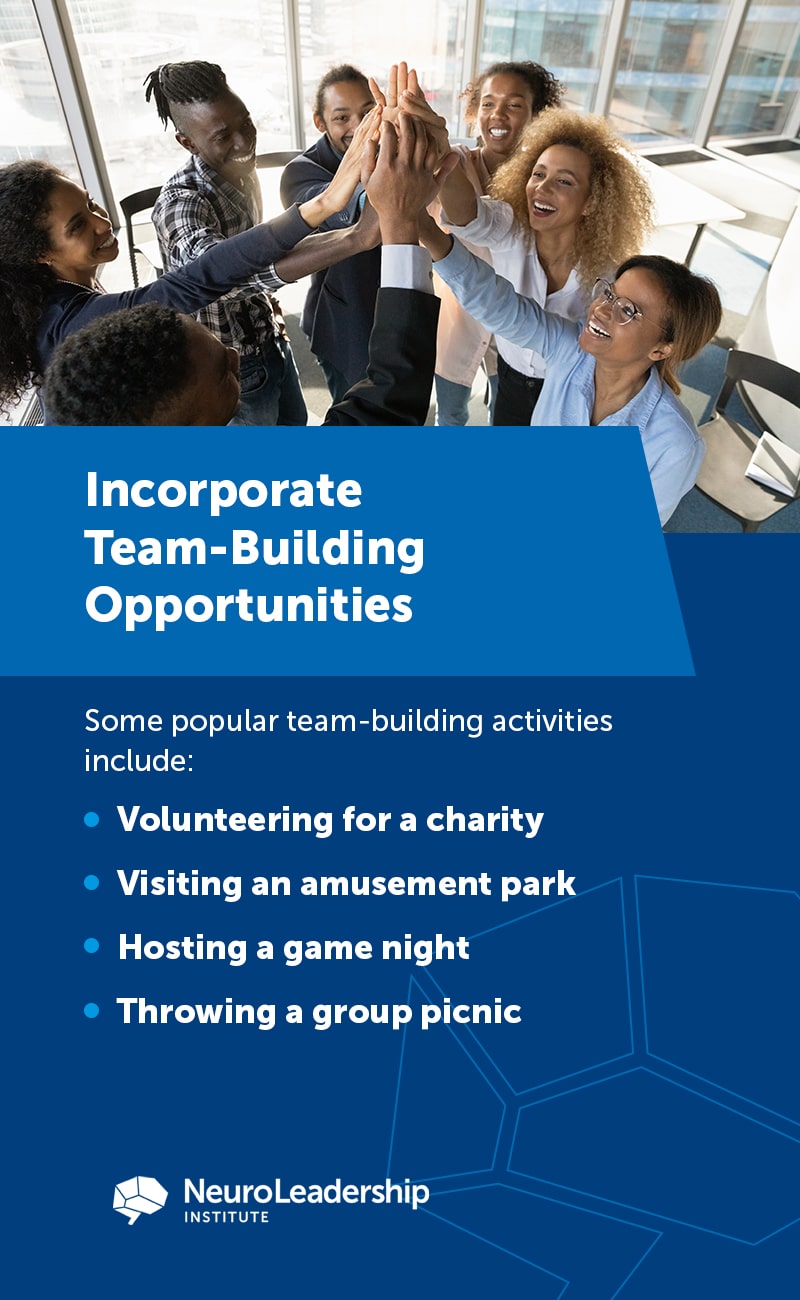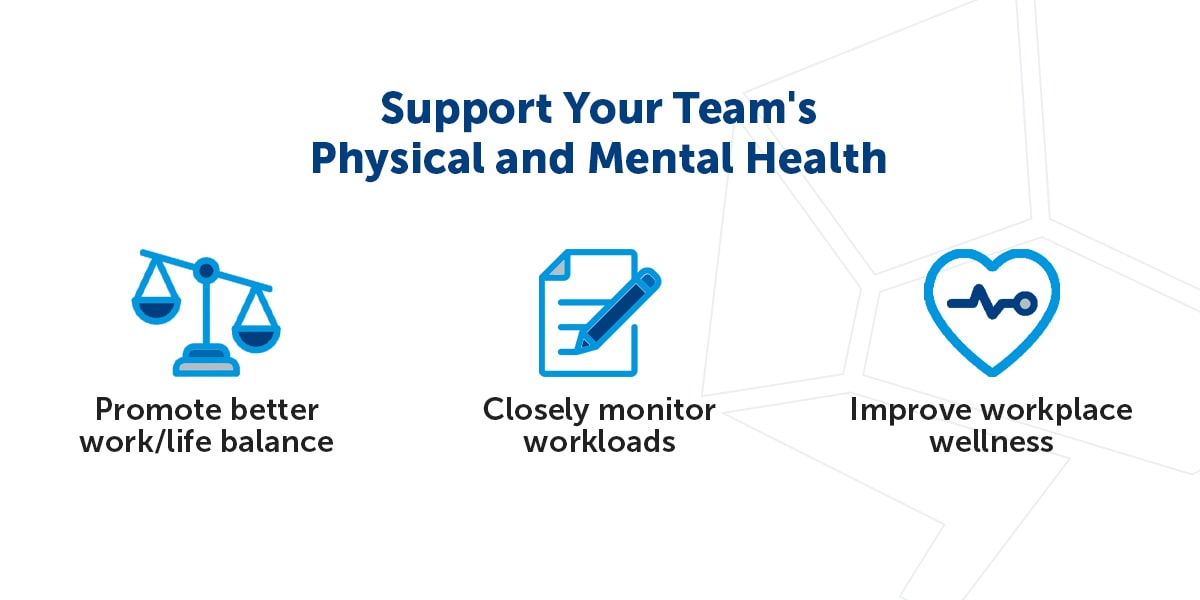
13 Tips for Increasing Employee Engagement
Boosting employee engagement is one of the most effective ways to improve your organization. You can enhance productivity and reduce turnover by taking steps to help your team members feel more valued and immersed in their work.
We are breaking down some valuable tips for promoting engagement among your team. From rewarding hard work to encouraging healthier communication, there are many ways to improve your practices and make your employees proud to be part of your organization.
Learn more about our top recommendations for increasing employee engagement and how the NeuroLeadership Institute for Individuals can help.
1. Use Positive Reinforcement
Positive reinforcement is one of the best tools for promoting employee engagement. It involves adding a desirable stimulus after a specific behavior, making it more likely the person will repeat those actions in the future.
Establishing positive reinforcement through rewards or recognition can inspire team members to work harder. And once you acknowledge their contributions, they'll feel more motivated to meet their next goal.
The following are effective types of positive reinforcers you can use in the workplace.
- - Natural: A reward received as a direct result of a specific behavior or accomplishment is a natural reinforcer. An example may be a worker getting a raise for consistently exceeding campaign goals.
- - Social: When a leader expresses approval and recognition for activities or achievements, this is a social reinforcer. You can use this type by sharing your appreciation for employee accomplishments in a team newsletter or during a meeting.
- - Tangible: Another way to use positive reinforcement is with tangible rewards. You can give your team members bonuses or other treats to recognize and incentivize their efforts.
- - Token: Like tangible reinforcers, you can award tokens or points to workers that perform specific actions. These tokens typically accumulate, and employees can exchange them for a valuable reward.
Leaders can harness their understanding of positive reinforcement to help their team members gain confidence and find inspiration. When you familiarize yourself with how the human brain works, you can use it to your advantage and improve how your employees engage with their work.

2. Give Your Team Autonomy
Every worker has unique strengths and weaknesses. By giving your team autonomy in the workplace, you allow them to have stewardship over how they get their jobs done. This freedom enables employees to enjoy more control over their to-do lists. However, autonomy is not about having free rein. Instead, the goal is to allow people to find their preferred paths toward achieving goals.
A few examples of employee autonomy include allowing your team to set their schedules or decide if they want to work from home or in the office. This level of independence and work-life balance has never been more valuable to workers than it is right now.
In a recent employment study, 59% of respondents stated that having this kind of flexibility is more important than how much money they make or the other job benefits available to them. When an employee can make more decisions, they will feel a stronger sense of trust needed to be an effective self-starter. Plus, employees with extra freedom are more likely to experience high job satisfaction.
3. Encourage Ongoing Feedback
Another way to boost employee engagement is by creating a safe, welcoming space for feedback. Every member of your team deserves the opportunity to speak their mind and have their voice heard. By creating a system to collect insights and suggestions from your workers, you can establish a culture of innovation and mutual respect.
Organizations can use employee input to inform decision-making. Leaders must communicate effectively with their teams to build a solid business foundation. Encourage your employees to share new ideas and ask them about any existing pain points in their daily processes. These insights will allow you to refine your practices and make changes that benefit the entire team.
By providing your employees with regular opportunities to submit feedback, you can eliminate some of the stress and anxiety they may feel about sharing grievances or recommendations.
Whether you orchestrate monthly feedback meetings or send out employee surveys every quarter, there are many ways to support ongoing comments and criticisms. You can also provide your team with a suggestion box so they can submit their ideas whenever they feel inspired.
4. Provide Professional Development Opportunities
You can also improve your business' employee engagement by providing opportunities for professional development.
Many industries are evolving rapidly. Employees can stay on the pulse by participating in ongoing learning efforts. Continued education and career development opportunities can yield the following benefits for workers and employers:
- - Improve job performance
- - Discover innovative skills
- - Refine existing practices
- - Grow earnings
- - Gain a competitive edge
The following are some examples of professional development opportunities your business can provide for team members.
- - Reimbursement programs: You can offer to reimburse employees for enrolling in approved educational programs outside work.
- - Training: Your business can provide or outsource different training programs to help your team gain new skills in person with an experienced instructor.
- - Courses: If you are more interested in low-key career development opportunities, offering digital courses is an excellent way for your team to participate on their time.
By facilitating these career growth opportunities, you can make your team feel highly valued. When workers feel well-equipped and supported by their employer, they will be more likely to engage with their work and find meaning.
5. Promote Your Company Values
Your organization can improve and transform how your employees engage with their work by regularly promoting your company values. If you do not have them already, your business should establish an intentional mission statement and some core principles. They should be unique and representative of what your business strives to be at its best.
Be sure to emphasize the role these values play in your processes. By training each member on your company's mission, you can better demonstrate how embodying these beliefs will positively affect their work.
People want to feel connected to their jobs. Employees should understand and feel a kinship to your business' core values. They inform every aspect of your organization and make up your company culture.
Ensure your leaders are glowing examples of what it means to be part of your business. When a team member feels aligned with your core values, it can be highly motivational.
6. Support Your Team's Physical and Mental Health
Your business can also improve worker engagement by supporting your team's physical and mental health. Overly stressed and fatigued employees can adversely affect your operations.
By taking steps to support a healthy, happy staff, you can keep your team working efficiently. Explore some of the ways you can help your team reduce burnout and maintain productivity.
- - Promote better work/life balance: You can help your team establish better balance in several ways, such as encouraging them to use all their vacation time and accommodating flexible schedules.
- - Closely monitor workloads: Ensure every person has a reasonable amount of work to keep them busy without creating unnecessary stress. You can avoid overloading workers by closely monitoring everyone's schedule.
- - Improve workplace wellness: Including wellness in your operation is a beneficial way to prevent burnout. Some companies choose to create a wellness program to help staff learn how to cope with stress. Others establish a quiet space in the corner of the office where team members can unwind when they feel overwhelmed.
7. Refine Your Onboarding Process
Employee engagement begins during the onboarding process.
Establishing a foundational onboarding plan will help you identify potential employees who are a good fit for your business. As new members join your staff, they need to learn about your company culture upfront. This process sets the tone for how someone interacts and connects with your organization.
Clearly communicate the following about your business while onboarding employees:
- - Core values
- - Mission statement
- - Vision and long-term goals
Part of onboarding is establishing your expectations as a business and helping the individual see where they fit into the big picture. One of the best ways to encourage employee engagement is to prioritize it from Day One. Ensure potential hires are ready and willing to put in the work. Transparency is critical here, because about 16.45% of new hires quit after a week, and 17.42% leave after only a month.
Do not be afraid to ask for feedback on your onboarding process as well. You could learn more about refining your practices and creating the best protocols possible.
8. Evaluate Your Communication Practices
Transparent communication is the cornerstone of any successful team. When considering how to enhance employee engagement at your business, take a minute to assess how the crew communicates. What platforms do they use? Do your workers talk to each other in a way that aligns with your company's core principles? Do you communicate differently with those working in the office versus those working from home?
Prioritizing open and honest communication practices can make your people feel more comfortable. When your team feels safe, they will likely be more willing to share their thoughts and concerns. Workers want to feel heard and understood. Taking some time to refine how you speak among your team can be highly beneficial for driving engagement at work.
9. Implement a Peer-to-Peer Recognition Program
A peer-to-peer recognition program is another effective way to enhance employee engagement and inspire your team to keep up the good work.
As a form of positive reinforcement, a program that allows co-workers to celebrate each other's successes and efforts can be highly motivating. Establishing a peer-to-peer recognition program can inspire a sense of belonging and connectedness. It can also incentivize working hard.
A study involving publicly awarding thank-you cards to the top three performers in a small work group found that every member's performance increased following the reward. Peer-to-peer rewards are a great way to inspire your team to hold each other accountable and offer recognition for outstanding work.

10. Incorporate Team-Building Opportunities
Bringing your staff together for team-building activities is an excellent way to encourage engagement. If you have a hybrid workforce, in-person opportunities can gather more of your staff together in one place. Some popular team-building activities include:
- - Volunteering for a charity
- - Visiting an amusement park|
- - Hosting a game night
- - Throwing a group picnic
Whether you're giving back to the community or playing a competitive game of Scrabble, these outings are an opportune time to demonstrate your business' core values. As your team works on or experiences something new together, they'll also have a chance to bond and build on their relationships. Tightly knit workforces tend to be more engaged.
11. Match Assignments With Your Employees' Skill Sets
As a manager or leader, prioritize getting to know your staff as individuals. You should evaluate their skill sets, personalities, talents and preferences.
You can then use these insights to assign work to the person on your team best suited for the job. When you understand your team and their individual strengths, you can put them in positions to maximize their contributions. Your business can boost employee engagement by offering meaningful work to your staff that fits their unique skill sets.
12. Prioritize Quality Job Training
Businesses should also offer high-quality job training experiences to improve worker engagement. A well-versed team has confidence and the tools to boost productivity in the workplace. People desire growth and development in their jobs, and training programs can help your workers harness new skills and ideas.
Mentorship and learning opportunities can inspire people to engage more deeply with their work. Job training should be highly specific and comprehensive for each unique position. As with onboarding, job training sets the tone for an employee's experience with your business.
Be sure to ask for constructive feedback to continuously edit and improve your training programs.
13. Discuss Engagement Often
Employee engagement is not an item your business can check off its to-do list. Instead, your organization should continuously improve your workers' experiences and find new ways to motivate them.
Demonstrating your dedication to your team can establish trust and create a workplace where everyone feels heard and seen. An ongoing conversation about engagement will help your leaders align their processes with your company values and mission.
Openly ask your team for feedback about their engagement levels to determine what factors impact their performance most.
Improve Employee Engagement With the NeuroLeadership Institute for Individuals
Worker engagement is paramount for optimizing your organization's processes and creating the best environment for your team. At the NeuroLeadership Institute for Individuals, our science-backed coaching programs can teach you important lessons about how the brain works and how to enhance your leadership skills.
Our Brain-Based Coaching program and CFN Certificate in the Foundation of NeuroLeadership will help you develop and hone valuable skills for leading your team to success.
Are you interested in getting started? Schedule a discovery session for more information about our programs today!


